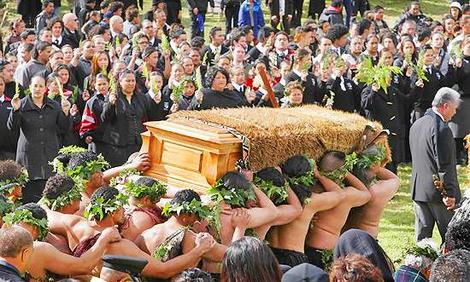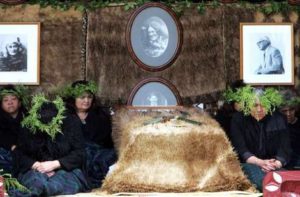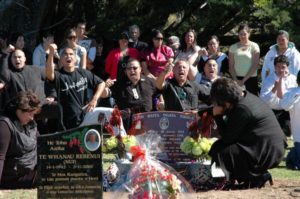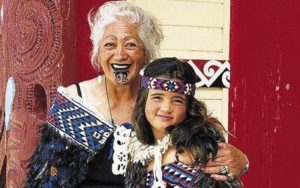
Traditional Maori dance
Credit: fourcorners.co.nz
The Maori people are an indigenous group of Polynesian New Zealanders whose ancestry can be traced all the way back to the 13th century. Due to centuries of isolation, the Maori have established a distinct society of characteristic art, language and mythology.
While common defining aspects of Maori traditional culture include their tattoos, dances, and legends, the Maori community approach the subject of death in a dissimilar way from Americans. A traditional Maori funeral, also called a Tangihanga, is an elaborate practice with designated stages and customs in which the entire community takes part.

A traditional Maori funeral
Credit: smh.com.au
Although Tangihanga is the name distinguished for general Maori mourning, there is a difference in custom between expected and unexpected deaths. The expected passing of a loved one is prepared for in advance with a ceremony known as Ohaki, or Final Words. This involves the gathering of family and friends to the home of the sick or disabled as an attempt to fulfill the dying person’s wishes, making for an easier transition into the afterlife. The Ohaki especially value food and drink, as the dying person’s intakes are regarded as signs of their chances of survival. During this time, any words that are spoken to the dying person are received with great seriousness and sacredness.
The Ohaki is followed by a Tuku Wairua, or Spirit Leaving Ceremony. The procedure is performed in order to permit the spirit’s smooth departure from the body and into the afterlife without restlessness. During this ceremony, those acknowledged as spiritual shepherds in the community will conduct daily services of religious significance to those gathered. These usually include prayers or blessings appropriate to their faith which, today, tends to be Presbyterianism.

Credit: smh.com.au
The unexpected death of a loved one is handled in a different manner. There are no final words or transition times dedicated to the deceased. Instead, the Maori move right to the ceremony of Ko Mate, or death. This ceremony is experienced in four stages, or changes, both for expected and unexpected deaths, although each might be handled differently depending on the situation. The first change involves the spirit. At the moment of death, the Maori believe the spirit leaves the body and travels to its old haunts before transitioning to the afterlife. The spirits of the unexpectedly deceased are believed to linger longer than those who die of natural causes.
The second change deals with the body. Even while alive, the body is considered sacred, so after the spirit has passed, certain activities like eating are not allowed near the body, and those who touch the body must immediately wash their hands. All sudden deaths require an autopsy, however, they are normally performed with expected deaths as well. The body is kept out and admired by guests like many American wakes, but incantations and prayers are often recited while simultaneously removing putrefying elements out of the body.

Credit: plus.google.com
The third change deals with a change in the status of the family left behind. With expected deaths, the family is usually allowed more free reign. They are accorded an extra respect and relieved of any responsibility to speak during the funeral. After an unexpected death, however, the family is bombarded with forensic responsibilities, and the coroner, police, pathologist and mortician are involved by right of law. The family is only involved if the professionals allow them to be.
Finally, the fourth step involves the place of death. The building or place of death during an expected death is blessed and treated as sacred, and many remember and visit this spot to mourn. The place of an unexpected death ultimately becomes a scene of investigation, and earns little to no acknowledgement.
After these ceremonial services, the tradition continues for many days, consisting of many concluding ceremonies during which the body is placed in the ground and the Maori follow certain diet and performance restrictions. The Hakari, or the Thanksgiving Meal, is one of the last ceremonies of a Maori funeral, and is a very important feast that removes the last vestiges of restrictions imposed by death.

Credit: kiwiagogoland.wordpress.com
Although the Maori people may have different traditions than Americans or other cultures, their acknowledgement of death is similar in that a community comes together to remember and celebrate the life of the deceased loved one. By understanding the different funeral practices that exist around the world, a more inclusive vision of death can be achieved.

 Tangihanga: A Look Into a Traditional Maori Funeral
Tangihanga: A Look Into a Traditional Maori Funeral


 “Hand to Earth” by Andy Goldsworthy
“Hand to Earth” by Andy Goldsworthy
 Trans Remembrance Project Provides a Community of Grieving
Trans Remembrance Project Provides a Community of Grieving
 Caring for a Dying Loved One? Be Gentle With Yourself.
Caring for a Dying Loved One? Be Gentle With Yourself.














